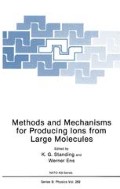Abstract
The interaction between slow (0.1–1.0 keV/atom) clusters with thin films has been studied by molecular dynamics simulation. Results are reported on the penetration of gold clusters through silicon [1] and on the interaction between carbon clusters with gold [2].
Substantial differences in energy spectra and angular distributions have been found in a comparison of cluster bombardment with monoatomic bombardment at the same projectile speed. For the purpose of tracing the origin of these differences, simulations were performed with the various interatomic forces switched on and off in a systematic manner [3].
Pronounced cluster effects were found in the specific energy loss per cluster atom, the energy spectrum of transmitted and reflected particles, and the energy spectrum of target recoils. In particular, pronounced tails were found of both projectile and target atoms with energies exceeding the kinematic limits familiar from linear collision cascades. The origin of these effects can be traced to clearing-the-way collisions [3], to collision cascades induced in the projectile cluster [4], and to multiply-hit target atoms [4].
Access this chapter
Tax calculation will be finalised at checkout
Purchases are for personal use only
References
V.I. Shulga and P. Sigmund, Nucl. Instrum. Methods B 47, (1990) 236–242.
Z. Pan and P. Sigmund, Nucl. Instrum. Methods B 51, (1990) 344.
V.I. Shulga, M. Vicanek and P. Sigmund, Phys. Rev. A 39, (1989) 3360.
P. Sigmund, J. de Phys. C2, (1989) 175.
V.I. Shulga, Radiat. Eff. 51, (1980) 1.
R. Biswas, G.S. Crest, and C.M. Soukoulis, Phys. Rev. B 38, (1988) 8154.
Y. Yamamura, Nucl. Instrum. Methods B 33, (1988) 493.
Y. Yamamura, Nucl. Instrum. Methods B 45, (1990) 707.
Author information
Authors and Affiliations
Editor information
Editors and Affiliations
Rights and permissions
Copyright information
© 1991 Plenum Press, New York
About this chapter
Cite this chapter
Shulga, V.I., Pan, Z., Sigmund, P. (1991). Stopping and Scattering of Slow Cluster Ions. In: Standing, K.G., Ens, W. (eds) Methods and Mechanisms for Producing Ions from Large Molecules. NATO ASI Series, vol 269. Springer, Boston, MA. https://doi.org/10.1007/978-1-4684-7926-3_19
Download citation
DOI: https://doi.org/10.1007/978-1-4684-7926-3_19
Publisher Name: Springer, Boston, MA
Print ISBN: 978-1-4684-7928-7
Online ISBN: 978-1-4684-7926-3
eBook Packages: Springer Book Archive

